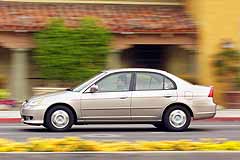
Base MSRP Range: $19,500 to $21,000
Base Invoice Range: $17,500 to $19,000
Price Quote
MSRP As Tested: $20,550
Versions: Manual or Continuously Variable Transmission (CVT)
Vehicle Category: Sub-Compact, Hybrid Fuel
Engine Location: Front Engine
Drive Wheels: Front-Wheel Drive
Engine As Tested: Electric, 1.5-liter, Single Overhead Cam, Inline 4 cylinder, 85-horsepower at 5,700 rpm and 116 lb-ft torque at 1,500 rpm
Transmission As Tested: 5-Speed Manual or optional Continuously Variable Transmission (CVT) Automatic
Fuel Economy (city/hwy): 5-Speed Manual - 46/51. CVT - 48/47.
Standard Safety Features: Driver and front passenger, front and side airbags, 4-wheel disc brakes, "> Antilock Braking System, In-Trunk Emergency Trunk Release, Remote Keyless Entry.
Competition: Honda Insight, Toyota Prius
Hardly a day goes by when the news doesn't contain some item regarding the environment, and usually the auto industry is the whipping boy in some way. Yet car companies have developed and offered high efficiency cars in the past, many which used less fuel than today's high-tech hybrids, albeit not quite as effective in reducing pollutants. And they also tried to market zero polluting electric cars, and lobbied with the energy companies to set up a network of charging stations in offices, parking lots, and even McDonald's. Still, the buyers have stayed away.
American buyers are missing one of the most amazing bargains, as these cars undoubtedly cost much more than the $20,000 price to build, let alone develop. Toyota, Honda, and soon Ford are investing in the future, getting some valuable real world usage and reliability data, but more importantly, performing a great public service by increasing the visibility and acceptance of these technologies.
The Civic Hybrid is Honda's second hybrid model, following the two-passenger Insight, and the similar Toyota Prius. Hybrids use a small, efficient gasoline (or diesel) engine, just powerful enough to maintain cruising speed, and uses an electric assist motor for acceleration. The electric motor is powered by batteries, which automatically recharge as the hybrid is driven. The vehicle does not have to be, in fact, can't be "plugged in."
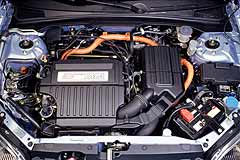
Its 1.3-liter, 4-cylinder gasoline engine and 10-Kilowatt electric motor combo can squeeze 650 miles from a single tank of gas. While it costs a few thousand dollars more than a conventional Civic, in the days of $1.50 gasoline, the extra 15 mpg will go a long way to making up the cost difference, and there are federal tax benefits as well. And just think how smug you‚ll feel among the neighbor‚s 15 mpg SUVs!
"More than half of new car buyers say fuel mileage is a major factor in their buying decision," said Dick Colliver, executive vice president of American Honda Motor Co., Inc. "This car is designed for people who want to spend less on gasoline, reduce their impact on the environment and still have a roomy, comfortable vehicle with a refined driving experience."
The Civic Hybrid model has only a few outward visual characteristics that make it distinct from a regular Civic. The front has slightly smaller openings in the grille and a deeper more pronounced air dam, all in an effort to provide better fuel economy by reducing the aero drag. On the right rear bumper the other obvious clue sits; a raised chrome "Hybrid" tag on a green background underneath with a "Gasoline/Electric" label. The only other real hints are lower resistance tires and wheels and a bit of lip on the trunk, again to assist in aerodynamics.
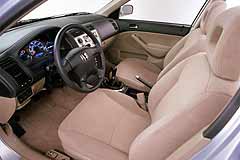
Thrifty does not mean Spartan. The interior still features premium seats and numerous luxury features such as cruise control, power windows, a clear and uncluttered illuminated instrument panel, an automatic climate control system and a high-power AM/FM/CD audio system. The Hybrid is equipped with standard alloy wheels, ABS and side airbags. Even the automatic version is high tech, with an efficient Continuously Variable Transmission (CVT) priced at $20,550 and delivering 48/47 city and highway mileage figures.
The interior is much nicer than a base model Civic with nice materials to present a refined look and a handsome instrument panel with chrome surrounds on the gauges. The air conditioning controls are arrayed vertically on the driver's side of the center console and feature auto vent and auto fan functions. The audio controls are located high in the console and don't require looking down too far to operate (a definite safety plus).
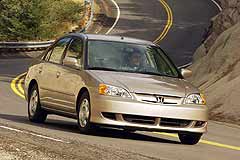
The ride is exceptionally soft, with not as much damping as some sportier versions, but nevertheless extremely comfortable at real word speeds and civilized cornering. The lightweight wheels and special low rolling resistance all season tires are aimed at improving fuel economy. The interior noise levels are moderate with the tires contributing the bulk of the noise, and they are not as effective in cornering or stopping. There is a price to pay for low rolling resistance.
The brakes are front discs and rear drums with ABS. The steering is electrically assisted rather than hydraulically (which would require an engine powered pump). The steering feels a bit numb and the steering seemed to be resistant to being moved off center, but once past the initial tug it felt ok.
Instead of the Insight's tiny 1 Liter engine the Civic Hybrid has a slightly larger 1.3 Liter engine. It makes 85 horsepower supplemented by a little over 13 horsepower from the electric motor. Unlike the Toyota Prius, which can run on either the electric or the gas engine, the Civic runs on the gas engine with an occasional supplement from the electric motor (acceleration and climbing hills for instance).
While the gas engine runs on unleaded regular, the electric motor runs on 120 Nickel Metal Hydride (NiMH) D cell batteries housed vertically behind the back seat. (Yes "D" cells, just like in flashlights). The batteries are charged with spare power from the engine. For instance when coasting down a hill the electric motor becomes a generator to charge the battery pack. It never needs to be "plugged in" as pure electric vehicles do.
To help you keep track of what's going on, a special gauge cluster is included to the right of the speedometer. This cluster includes a fuel gauge, a 'charge remaining' gauge, and a special monitoring tool that tells you at what rate you are charging or discharging the battery pack at. An instantaneous fuel mileage bar sits under the speedometer. With the gas and electric output combined acceleration isn't bad. Of course, you're not going to line up against a Civic Si and take home a drag racing trophy. It will keep up with traffic, it merges onto the freeways quite well and it generally feels like a competent economy car, and will pass all those import rockets at their many gas stops.
It is worth noting that you need to plan for less than optimal conditions, such as steep grades. Equipped with a manual transmission, this means going down a gear or two when climbing. When equipped with the Continuously Variable (CVT) transmission, it will keep the engine at the ideal speed for conditions. With either transmission, you may not be going as fast as those around you when the going gets steep.
One little trick the Civic Hybrid has up its sleeve is the "auto stop" function. Given proper conditions, under twenty miles an hour, under braking, and without the AC in max mode, the Civic Hybrid will shut down the engine. Steering is still there since it's electrically boosted. Once you put the car in gear (or step on the gas with the CVT equipped car) the engine starts up and off you go. We found the only annoyance with this was that the AC shuts down also, and some lights are red long enough for the interior to warm up a bit (especially when the outside temp was hovering close to 100 degrees). This idle stop system contributes to both greater fuel efficiency and lower emissions.
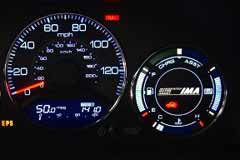
Driving the Civic Hybrid like a regular car will not optimize fuel economy. The instantaneous fuel gauge and the charge/discharge meter can be used to help train your right foot as to how to get the most for every gallon of gas you purchase. With a little learning you can get to the point where superior gas mileage is returned in a variety of conditions.
Honda feels it important to get these cars in the hands of the public to gain information and acceptance.
Pros: Incredible fuel economy. Does not need to plugged in and recharged. Ample passenger and cargo space. Good build quality.
Cons: Low horsepower. Steering is sluggish.
Ratings (1-10)
- Style: 7
- Performance: 5
- Price: 6
- Handling: 8
- Ride: 7
- Comfort: 7
- Quality: 8
- Overall: 6.9
MORE DATA
Where Built: Canada, Japan, USA
Major Options: None
Seating: 5
Number of Rows: 2
Crash Test Ratings: These ratings are for the standard Civic Sedan, not the hybrid fuel version. Crash tests thus may not be valid.
- NHTSA Frontal Impact/Driver Crash Test Rating: *****
- NHTSA Frontal Impact/Passenger Crash Test Rating: *****
- NHTSA Side Impact/Front Seat Crash Test Rating: ****
- NHTSA Side Impact/Rear Seat Crash Test Rating: ****
- NHTSA Rollover Resistance Rating: ****
- IIHS Frontal Offset Crash Test: Overall Rated Good
Length in Inches: 174.6
Warranties: 3 years/36,000 miles bumper-to-bumper, 5 years/unlimited miles corrosion, 8 years/80,000 Civic Hybrid Battery Pack,.
Weight in Pounds: 2,449
Towing Capacity in Pounds: Not Applicable
Gas Tank Capacity in Gallons: 1.3
Destination Charge: $460




